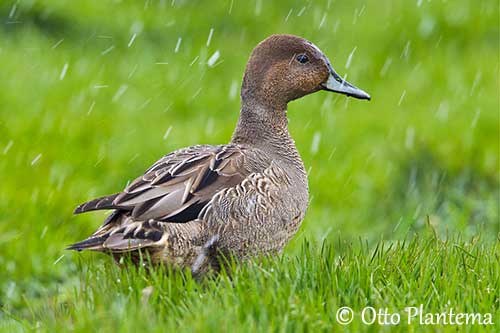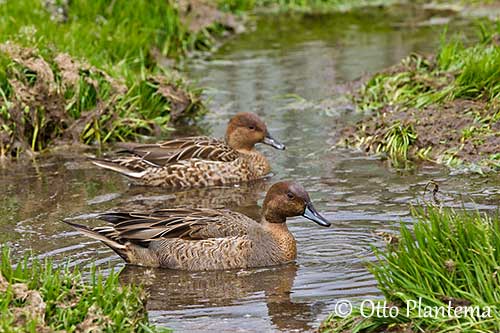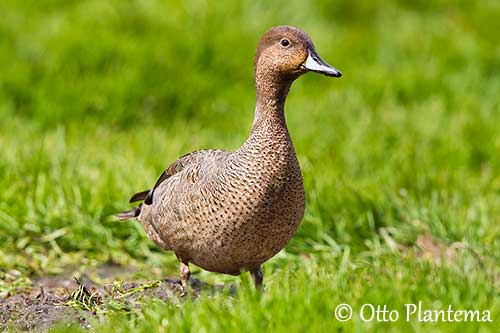
Fr: Carnard d’Eaton
Ang: Eaton’s Pintail – Southern Pintail
All: Kerguelenspießente
Esp: Ánade rabudo meridional
Ita: Codone di Eaton
Nd: Kerguelenand
Sd: kerguelenand
Photographer:
Otto Plantema
Trips around the world
Text by Nicole Bouglouan
Sources :
HANDBOOK OF THE BIRDS OF THE WORLD vol 1 by Josep del Hoyo-Andrew Elliot-Jordi Sargatal - Lynx Edicions - ISBN: 8487334105
GUIDE DES CANARDS, DES OIES ET DES CYGNES – de Steve Madge - Delachaux et Niestlé - ISBN: 2603013769
BirdLife International
HBW Alive
Wikipedia, the free encyclopaedia
Wildfowl: An Identification Guide to the Ducks, Geese and Swans of the World By Steve Madge
Eaton’s Pintail (or Southern Pintail)
Anas eatoni
Anseriformes Order – Anatidae Family
INTRODUCTION:
The Eaton’s Pintail is a now full species, but some authors do not accept this classification. It differs from Anas acuta – Northern Pintail by several morphological features. It is much smaller and resembles female with mostly brown plumage. The male lacks the full breeding plumage.
The Eaton’s Pintail is found on Crozet and Kerguelen Islands in S Indian Ocean. It is threatened by introduced cats and rats on the breeding islands, and has suffered heavy hunting pressure by sealers and scientific expeditions.
The population is still decreasing and this species has very restricted breeding range. It is currently classified as Vulnerable.
The name of this duck pays tribute to Alfred Edmund Eaton, English explorer and naturalist.

DESCRIPTION OF THIS SPECIES:
Biometrics:
Length: 35-45 cm
Wingspan: 65-70 cm
Weight: M: 430-500 g – F: 400-500 g
The Eaton’s Pintail is usually very brown overall. The upperparts are mostly reddish-brown and fairly uniform. On the wing, the speculum is green. On the tail, the central rectrices are slightly elongated, but less than in Northern Pintail. The outer rectrices are whitish.
Some males (about 1%) have brown head with white stripe on the side, making them very similar to Anas acuta.
The bill is blue-grey with conspicuous black culmen. The eyes are dark brown. Legs and webbed feet are dark grey.
In eclipse plumage (May to November), it is more similar to the female.
The adult female is smaller and darker than female Anas acuta. She has brown (not green) speculum, bordered with white.
The juvenile resembles female but it has more streaked underparts. The young male gets very soon a brighter speculum.
SUBSPECIES AND RANGE:
The Eaton’s Pintail has two subspecies.
A.e. eatoni occurs on Kerguelen Islands. It was formerly introduced to St Paul Island and Amsterdam Island, but the species disappeared from these islands.
A.e. drygalskii is found on Crozet Island. This race is very similar to nominate, but the underparts show narrower bars, more vermiculated, and it has slightly shorter wings.
HABITAT:
The Eaton’s Pintail forages mostly in coastal areas and sheltered bays during winter. It frequents freshwater pools, small lakes, marshes and streams. It usually avoids the areas of human habitations.
CALLS AND SONGS:
The Eaton’s Pintail has slightly higher-pitched voice than Anas acuta. It is generally quieter, including the young.
BEHAVIOUR IN THE WILD:
The Eaton’s Pintail is fairly gregarious and can be seen in small foraging groups outside the breeding season. It feeds mainly on crustaceans and invertebrates found in moist soil. Seeds and vegetation are also part of its diet. It usually feeds during the day, but while moulting, it also feeds by night to avoid predation.
The Eaton’s Pintail is usually more terrestrial than Anas acuta. It walks and runs on the ground and perches on rocks and boulders.

The mating behaviour is unknown, but pairs can be observed during the austral spring. The displays are probably similar to those of other Anatidae. They nest as single pairs. Their main predator is the Brown Skua.
The Eaton’s Pintail is sedentary, with some movements to coastal areas in winter. It is reported as vagrant to Prince Edward Islands.
This species is a good flier that moves easily throughout the island.
REPRODUCTION OF THIS SPECIES:
The breeding season takes place between November and March on Kerguelen Island.
The Eaton’s Pintail nests as single pairs, with the nest-site sometimes up to 500 metres of elevation. The nest is on the ground, often hidden in tussock or among grass. The depression is lined with moss and down. The nest may occasionally be placed in rock crevice.
The female lays 2-6 pale olive-green eggs and incubates alone. The duration of the incubation is unknown, but it lasts 22-24 days in Anas acuta, and we can suggest that it is the same or roughly similar for the present species. The chicks are smaller than those of Anas acuta. They are paler above with reddish dorsal spots and rufous tinge on face, breast and underparts. They are tended by the female alone and like in Anas acuta, they probably fledge 40-45 days after hatching.
PROTECTION / THREATS / STATUS:
The Eaton’s Pintail was formerly heavily hunted by sealers and scientific expeditions, with 200-300 shot each year. It is now threatened by introduced predators, especially feral cats and brown rats, whereas the natural predators are mainly skuas.
The population in the early 1980s was estimated to number 31,200/41,400 mature individuals, with 600/700 pairs on Crozet and 15,000/20,000 pairs on Kerguelen. This population is still decreasing.
The Eaton’s Pintail is currently listed as Vulnerable.
